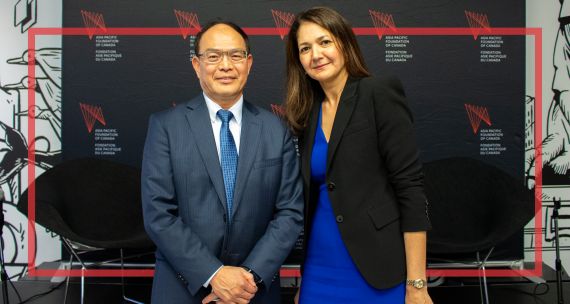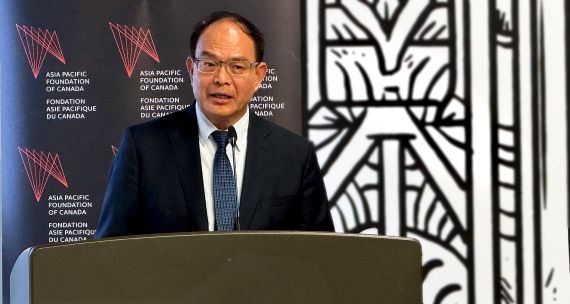Semiconductors, the ‘chips’ that are the basic building blocks of many modern technologies, enable breakthroughs in critical sectors, including defence, clean energy, and advanced manufacturing. The transformative potential of artificial intelligence (AI) and the Internet of Things is fuelling global demand for these chips, especially cutting-edge, high-performance ones. Building a robust domestic semiconductor capability has thus become a vital strategic priority for advanced nations such as Canada to safeguard both their economic and national security.
Taiwan, given its predominant role in the semiconductor industry, could be an indispensable partner for Canada in strengthening its position in the global semiconductor race. Taiwan produces over 60 per cent of the world's semiconductors and more than 90 per cent of the most advanced chips. Taiwanese juggernauts are also expanding their global footprint. Taiwan Semiconductor Manufacturing Company (TSMC), for instance, while retaining 90-95 per cent of its manufacturing investment for domestic capacity, especially in the most cutting-edge chips such as the 1.6 nanometre chips, is ramping up fabrication facilities in Japan, the U.S., and Germany. The leading chip manufacturer has pledged a total investment in the U.S. alone of roughly US$65 billion (including government subsidies).
Taiwan’s commanding lead in the semiconductor supply chain is being solidified, moreover, by the growing demand for state-of-the-art chips in advanced industries such as electric vehicles (EVs) and AI. TSMC, for instance, holds a monopoly on the production of graphics processing units (GPUs), which are vital in driving AI innovation. In addition to dominating semiconductor manufacturing, Taiwan also reigns across other key segments of the value chain, ranking first globally in packaging and testing, and second only to the U.S. in chip design.
While Canada has advantages that it could offer in a partnership with Taiwan, such as its strengths in research and development, it must first overcome domestic hurdles, including chronic underinvestment and a lack of a cohesive national semiconductor strategy.
The Current State of Canada-Taiwan Co-operation
Taiwan’s strengths in the semiconductor sector match Canada's needs. Taiwan is already a vital source of Canada's semiconductor imports: since 2011, it has consistently ranked among Canada’s top three import partners (alongside China and the U.S.) and has shown a steady increase in import volume. Taiwan was also Canada’s largest supplier of integrated circuits from 2019-23 (2023 is the most recent year for which data are available). In addition, TSMC’s Ottawa R&D centre expanded from 20 employees in 2007 to approximately 100 in 2024, focusing on next-generation semiconductor processes.
Recent high-level initiatives have boosted the potential for further Canada-Taiwan co-operation on semiconductors. These include the 2024 Canada-Taiwan Semiconductor Co-Innovation Forum, which connected leading Taiwanese manufacturers with Canadian players and led to the signing of the 2024 Science, Technology, and Innovation Arrangement and the endorsement of the Collaborative Framework on Supply Chains Resilience in 2023. Together, these efforts create favourable conditions for deepening Canada-Taiwan semiconductor collaboration.
Advantages of Collaboration
Taiwan’s leadership in semiconductor manufacturing aligns perfectly with Canada's ambitions to drive innovation in sectors such as automotive, AI, defence, and low-carbon technologies, all of which require semiconductors, particularly the high-performance chips manufactured by Taiwan’s industry leaders. Additionally, collaborating with Taiwan would provide reshoring and friend-shoring opportunities to build a semiconductor supply chain on Canadian soil. At the 2023 North America Leaders’ Summit, Canada, the U.S., and Mexico committed to developing a North American semiconductor corridor to create a regional supply chain. That supply chain would help ensure North American access to chips during global crises and shield them from overreliance on authoritarian regimes for sensitive technologies, including those used in AI and for military purposes.
Partnering with Taiwanese companies could allow Canada to become competitive as a North American centre for advanced assembly, testing, and packaging (ATP). Currently, most ATP facilities are in Asia, as North America lacks the necessary infrastructure, accounting for only three per cent of global ATP capacity. Teaming up with Taiwan's industry leaders thus provides opportunity. Canada has established an ATP presence at IBM’s large plant in Bromont, Que., and recently announced plans to increase these capabilities. Joint ventures and co-investments utilizing Taiwan’s technical expertise could fill a major gap in the North American supply chain. Meanwhile, Taiwan’s ATP powerhouses such as ASE Technology — the world's largest chip packaging and testing provider — are shoring up their presence in the U.S. and Mexico to address the regional shortfalls in ATP capacity.
For its part, Taiwan stands to gain from economic diversification. Taiwanese companies are already actively broadening the geographic footprint of their semiconductor fabrication operations to mitigate against the risk of over concentration, especially amid the rise in cross-strait tensions. Having a larger presence in Canada would be an important component of this strategy, by building a reliable link to markets and suppliers in the event of export restrictions or supply blockades by China.
The Complementarity of Canada’s Assets
Canada is not only a safe option for Taiwan’s economic diversification but also boasts considerable strengths that would complement Taiwan's semiconductor dominance. These include innovative research and development, niche chip expertise, and an abundance of critical minerals and renewable energy resources.
Canada has established itself as a global leader in AI research and development, with more than 670 AI startups and 30 generative AI firms. It introduced the world's first national AI strategy in 2017 and, since that year, has invested over C$2 billion into AI innovation. Ottawa committed an additional C$2.4 billion in its 2024 federal budget to help shore up the country's competitive advantage in AI. This massive investment and the rapid growth of Canada's AI ecosystem have created a voracious appetite for the types of cutting-edge, high-performance semiconductors produced by Taiwan's flagship companies.
Another Canadian asset is the country’s rapidly growing capacity to supply the critical minerals essential for semiconductor manufacturing. China currently has a firm grip on the global supply of materials such as gallium (98%) and germanium (68%), creating long-term supply chain vulnerabilities for Taiwan. Canada offers a promising alternative, with firms such as Neo Performance Materials churning out high-purity gallium and Vancouver-based Teck Resources, one of the world’s top producers of integrated germanium. Both minerals are vital for making chips. In addition, as the fourth-largest global producer of indium, Canada could be a welcome alternative to China as Taiwan’s supplier of that rare earth mineral.
Canada's ample supply of renewable energy resources, including hydroelectricity, solar, and wind, generate some of the cheapest electricity and ensure a more stable and predictable energy supply, thereby potentially reducing the operating costs for semiconductor companies. As environmental pressures mount, Canada's clean energy expertise could also enable the development of semiconductors for emerging clean technologies, such as solar panels and wind turbines and minimize the ecological impact of energy-intensive chip manufacturing.
Overcoming Domestic Challenges
Despite these considerable strengths, Canada's semiconductor sector is facing headwinds. A major structural hurdle is chronic underinvestment — Ottawa’s C$556-million investment is dwarfed by the U.S.’s US$53-billion, Germany’s US$22-billion, and even Spain’s US$12.4-billion investments into their domestic semiconductor industries. Such deficiencies have already hamstrung one of Canada’s biggest selling points — its abundance of critical minerals. That sector also needs substantial investment, especially as Canada’s extraction capacity lags. That is particularly the case for Canadian firms seeking to develop a capacity to extract in a way that is environmentally friendly but costlier. Ironically, many Canadian mining companies with interests in critical minerals are tied to Chinese investors, a result of years-long underinvestment by Canadian entities.
Fragmentation is another issue plaguing Canada’s sector; it has more than 500 firms operating in the field, but 86 per cent of them are small businesses with fewer than 100 employees. A mere one per cent of these firms employ more than 500 employees, making economies of scale — critical for semiconductor players competing globally — extremely difficult to establish.
More crucially, Canada lacks a cohesive national semiconductor strategy. In niche markets where Canada can be a world leader — for instance, sensors for EVs or photonic chips for 5G telecommunications — specialized chips cost substantially less than advanced chips but could still be an opportunity for Canada to carve out a unique competitive edge.
Some experts have suggested that Canada should concentrate on the upstream and downstream segments of semiconductor manufacturing such as business model design and ATP, which don't require the exorbitant investments needed for fabrication facilities. With a comprehensive national semiconductor strategy, Canada could also tackle the chronic issues of underinvestment and industrial fragmentation and become a meaningful partner for Taiwan and others in the global chip sector.
Securing Canada's Future Through Partnership with Taiwan
With a future increasingly defined by technological advancements, Canada must remain competitive within the rapidly expanding semiconductor ecosystem, or it risks technological dependence, economic stagnation, and a diminished role in shaping the future of these critical technologies. Meanwhile, countries such as the U.S., Japan, and members of the European Union are actively reshoring semiconductor production to establish regional supply chains. If Canada fails to secure a seat at the table, it could miss out on opportunities from these collaborative ecosystems and lose access to shared resources, expertise, and markets.
Taiwan's undisputed global leadership in semiconductor manufacturing, complemented by Canada's key strengths in research, critical minerals, and clean energy, present a tantalizing opportunity for bilateral collaboration — particularly in harnessing Taiwan’s advanced technological know-how. Nevertheless, fully realizing this immense potential will require not only strategic investments in the semiconductor domain, but also a strengthened sense of national resolve to stand with democratic allies — demonstrating to the island Canada’s commitment to fostering close economic ties and a resilient, forward-looking partnership.
• Edited by Erin Williams, Senior Program Manager, Vina Nadjibulla, Vice-President Research & Strategy, and Ted Fraser, Senior Editor, APF Canada.





